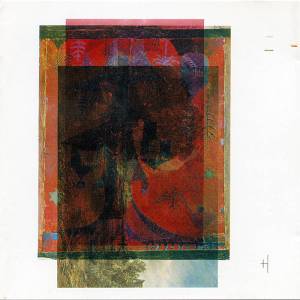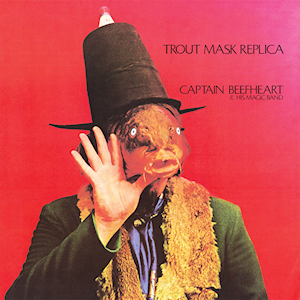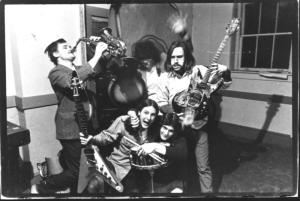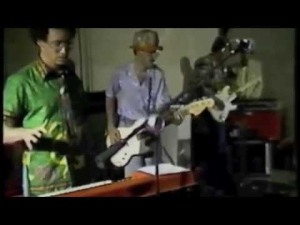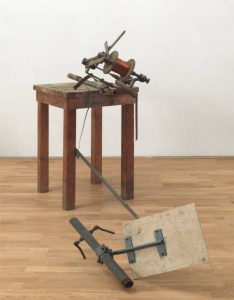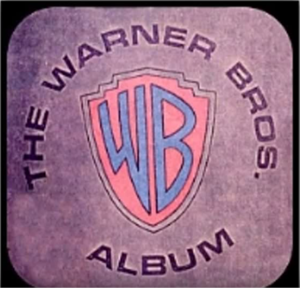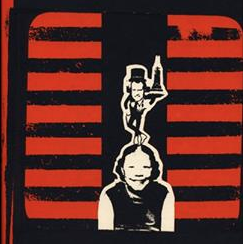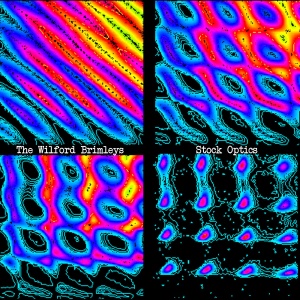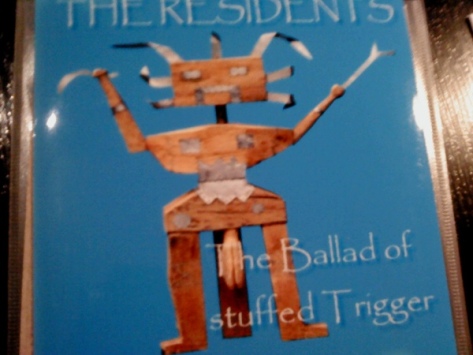Mac McCloud-“A. Mac McCloud/B. Mac McCloud”
The first section consists of overdubbed vocal drones. The second section is a beatnik-esque spoken word piece that consists of two voices overdubbed on top of each other.
Harold Schroeder-“Silent Rituals”
This piece features desolate electronic drones that were performed on a synthesizer, but sounds like they could’ve been produced on a Hammond organ. It also has some electric guitar sounds, bass, oboe musette, and some mechanical noises. Later, you hear a distorted voice that sounds like it was spoken through a dictaphone.
Greg Neutra/J.D. Elliot-“Grieg Fatigue”
A sound collage consisting of recordings of classical music being layered on top of each other.
Smegma-“A. Rrose Selavy Will Wait For My Washing Machine, Even/B. The Andalusian Dog Often Digs into the Furniture with Onyx Fingers”
The first track consists of a recording of a washing machine and some out-of-tune trumpet-like noises. The second track is a recording of a saxophone being played backwards, backed by oscillator drones.
Smegma-“Potatoe War”
Starting with a deep chanting, a short diddy with vocals about potatoes and a Jew’s harp plays for the rest of the song as the chant continues.
Fredrik Nilsen-“You Can’t Hide From Aldehyde”
A collage of tape loops of random freak-out weirdness.
Le Forte Four-“Discarded Portion of the Soundtrack for Rick’s Film “Burger Madness”
A 14-second noise collage piece, as performed on a “Boop-o-graph” by Joe Potts, that was used as part of the soundtrack for a high school film project that Joe’s brother Rick Potts had made. I was lucky enough to ask Rick on Facebook about it, since he was one of my Facebook friends, he told me that the film was about a guy who goes to Jack in the Box, eats a cheeseburger, and then has hallucinations.
Miles Forst-“Art, Art, Art”
A recording of a woman making coughing sounds, along with some background noise and dialogue.
Smegma-“One Moment”
A sound collage of a rock music jam session (that was later reversed) and samples from various music and TV shows (or radio broadcasts), all spliced together and manipulated in an interlocking manner.
Smegma-“Pigface Blues”
A short diddy with vocals and out-of-tune acoustic guitar.
Doug Henry-“View This Command as a Verbal Enactment of a Command”
Just 15 seconds of the guy saying the track’s title (backed by an electronic buzz), followed by some silence.
Josie Roth-“Heal, and Another Little Time”
A recording of what sounds like a toy animal, or something like that.
Joe Potts-“I Don’t Want to Go to the Farm”
A collage of random singing voices.
Otto Fick-“Untitled”
A tape loop of flute sounds and a voice about satisfaction. A different voice accompanies the tape loop. The track ends with an out-of-tune flute finale.
Smegma-“Excerpt From: I’ll Have Julie Nixon-Eisenhower For My Appetizer (Sour Lungs to My Surprise)”
A noise rock jam with distorted electric guitar, bass, flute, kazoo, random sounds, strange vocals, and weird electronic effects that sounds like a UFO. An extreme attempt at trying to impersonate The Mothers of Inventions’ 1968 album We’re Only in it For the Money.
Karen Kato-“Xmas 1952”
An old home recording of the Kato family during Christmastime in 1952, as recorded on a phonograph. The recording ends with a locked groove, meaning that the last part loops at the end.
J. J. Allen Vargas-“Victim of Racism”
The first half consists of records being speed-manipulated with a turntable. The second half consists of samples from Looney Tunes cartoons.
Le Forte Four-From “The Origin of Largie Shrapnel”
Performed by Rick Potts with trashcan tympanies, bass, piano, and cartoonish vocals, this was an excerpt from another film project by the aforementioned composer.
Dennis Guy Mehaffey-“Busta Nosa”
A piece consisting of warped records that could also have been speed manipulated. This perfectly recalls the second Neu! album.
M/R/Zuniga-“Vulnerability: Rape, Male vs. Female”
Beginning with some tiny sped-up voices and electronic percussive sounds, this leads into a creepy horror movie-style piece with a teenage girl repeating the words “raping my mind” like a schizophrenic.
Mike Green-“Martin Heiddeger Revisited”
A collage of a rapid spoken word piece and singing.
Le Forte Four-“I Haven’t Heard You For A Long Time…”
A short conversation between a woman and Chip Chapman on a CB radio. This piece was recorded at “Loud Mouth” Dunn’s CB shop in El Monte.
Dennis Guy Mehaffey-“A. Introduction by Buckminster Fuller/B. I Stumble/You Laugh”
The first track is a spoken introduction about a radio broadcast. The second track consists of a piece with strange guitar sounds and mechanical percussion. The guitar was played by the one and only Mr. Foon, who also recorded a piece for this album.
Le Forte Four-“Fat Ape”
A piece composed by Tom Potts for distorted voice and Mexican radio. The way the voice is distorted sounds like it was processed through a cheap vocoder-esque device.
Jules Lemelle-“Untitled”
A field recording backed by the sound of a clock ticking. You also hear a motorcycle revving later on. The sound quality makes it sound like it was recorded on a cassette tape.
Maureen Abbott-“Untitled”
A 14-second recording of a woman speaking, backed by an electronic buzz.
Smegma-“Take One”
An free jazz composition featuring an out-of-tune hammer dulcimer, bass, clarinet drones (both performed on an acoustic clarinet and a metal clarinet), koto, “flax”, trombone, violin, and tape effects (credited as “toons” on the original release).
Dan Weiss/P. Hamilton Ross-“A Bicentennial Tribue to America’s Freight Trains”
A recording of two guys talking about freight trains in a beatnik manner, along with some harmonica sounds.
Mr. Foon-“Timeless #1”
The album’s longest track, clocking in at 5:50. This track is a sound collage consisting of a continuous, stereo-panning tape loop of a telephone voice sample (it pauses at points throughout the song), singing, various samples, out-of-tune instruments, and random noises.
Bertil Petersson-“Monologue to Henry VIII”
A spoken word voice consisting of a woman, in a number of voices, speaking as if to King Henry VIII.
Amrein & Stoll-“Untitled”
A piece featuring: (1) deep electronic drones and African thumb piano, (2) deep saxophone-like noises, (3) an electronic rumbling sound, and (4) more deep drones and some metallic clanging.
Ace & Duce-“Dogs Are Barking”
A short recording of acoustic guitar, a man singing, and a dog barking.
Irene Dogmatic/Rose Tattoo-“Untitled”
A piece featuring a reverbed female voice, another voice (that sings later on), and some acoustic guitar playing.
Gordon Shields-“Cotton Duck, Up and Back”
A recording of some tearing noises with the tape played backwards and forwards.
Donald Spaulding-“I Don’t Want This to Happen”
A tape loop of the guy saying the words of the title.
Tom Kemp-“Pasadena Subway Station Poetry Stills”
A recording of the guy reciting his poetry in a subway station, with real acoustic reverberation on the guy’s voice.
Janice Felger/Joan Hugo-“One Minute of Art News Update in 30 Seconds”
The title says it all!
Sue Farthing-“Untitled”
22 seconds of background noise
Waynna Kato-“White/Noise”
To me, this track sounds like a lo-fi recording of scraping violin noises backed by some old recordings and other random sounds. At the end, you hear a recording of an electric guitar playing a surf music-style melody.
Jim Abuan/Peter Muzzey-“Why Does Love Have To Be So Sad?”
A loud refrain recorded over the telephone.
Juan Gomez-“This is My Country”
A lo-fi recording of schoolchildren singing the titular song, backed by a grand piano, glockenspiel, and percussion.
P.J. Campbell-“Untitled”
Just one minute of silence with nothing else!
Kathe Schreyer-“Don’t Make Me Laugh”
A woman making high-pitched laughing. At the end, the recording sounds like it was going through a filter, with some reverb to top it all off.
Mary Dana Chodzko-“Patty Smith by Mary Dana Chodzko”
A poetic a capella that could easily be one of the very first hip-hop songs!
Gary Laskin-“Have Sex With Rex”
A recording of a fictional dating service.
Jean Koller-“Dream”
And so, the album ends with a woman giving a description of one of her dreams.
